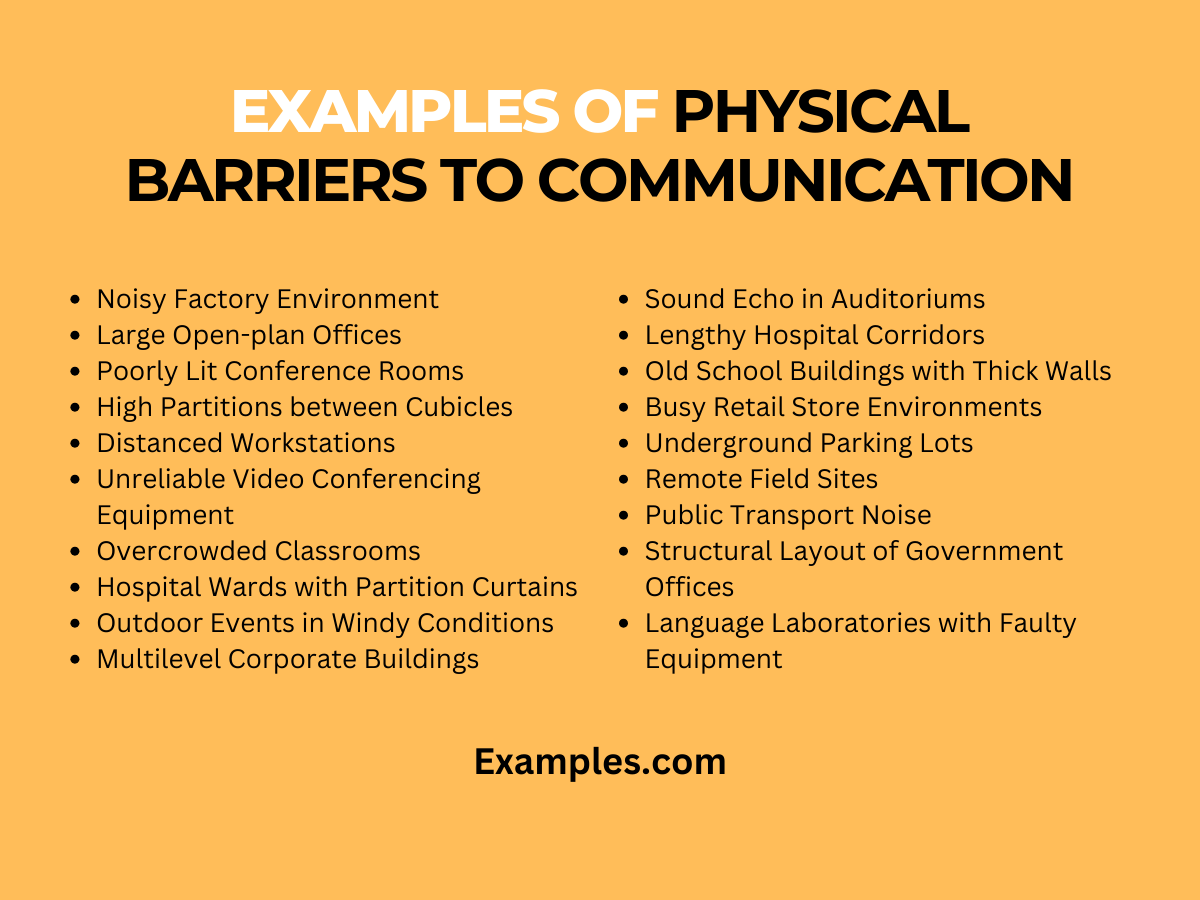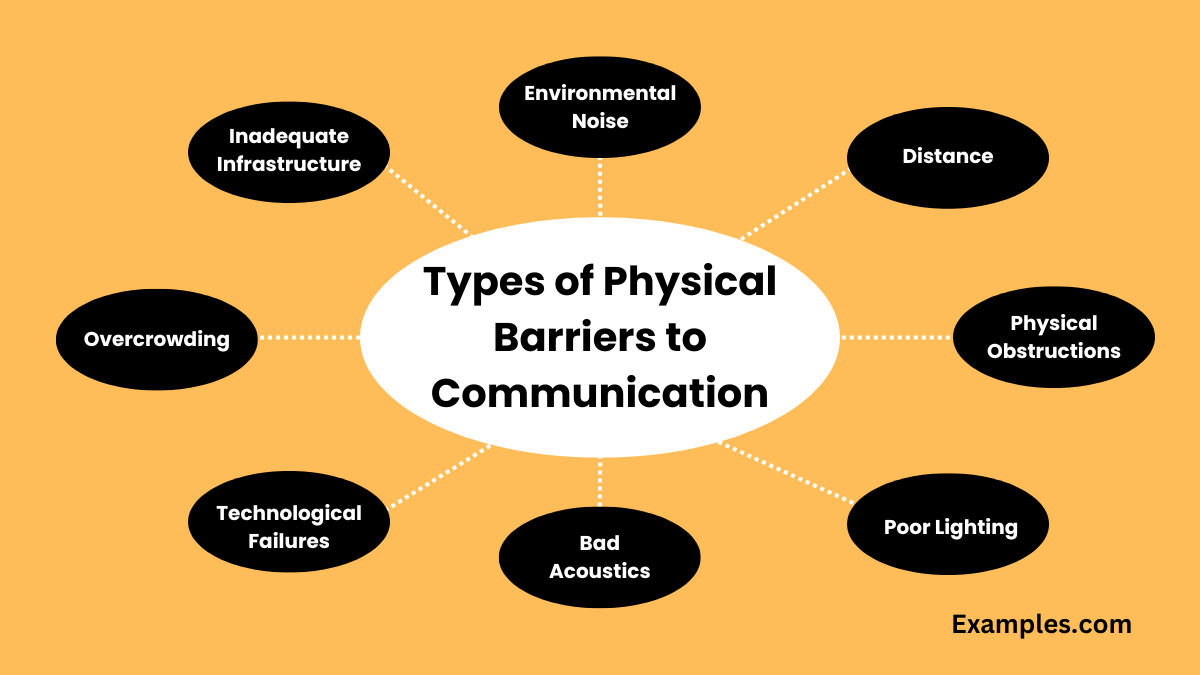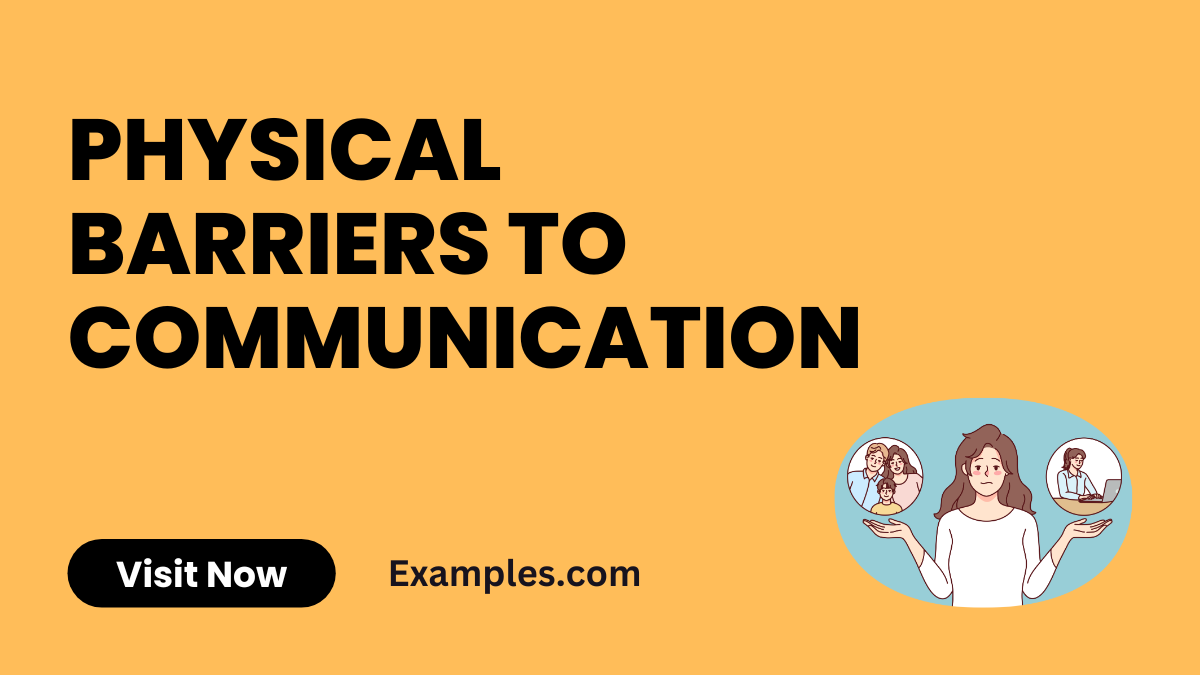19+ Physical Barriers to Communication Examples
Understanding Physical Barriers to Communication is crucial for anyone looking to enhance the clarity and effectiveness of their interactions. These barriers, which can range from environmental noise to geographical distance, significantly impact how messages are conveyed and received. In this guide, we’ll explore various physical obstacles that can hinder communication, providing insights and practical tips on how to overcome these challenges, ensuring your message is not just heard but also understood.
What are Physical Barriers to Communication?

Physical Barriers to Communication are tangible obstacles that can hinder the transmission and reception of messages. These barriers include environmental factors like noise and distance, structural obstacles such as walls or partitions, and even issues related to technology or equipment. Understanding these barriers is essential for identifying and implementing strategies that can minimize their impact, thereby enhancing the effectiveness of Intercultural Communication and ensuring that the intended message is accurately conveyed and understood.
What is The Best Example of Physical Barriers to Communication?

A classic example of Physical Barriers to Communication is a noisy factory floor, where the sound of machinery can drown out conversations, leading to miscommunication among workers. In such scenarios, alternative methods of communication like visual signals or the use of technology, such as headsets or intercom systems, can be employed to ensure that instructions and information are communicated effectively, despite the challenging environment.
20 Examples of Physical Barriers to Communication

Physical Barriers to Communication are often overlooked but can significantly impede effective interaction. These barriers range from environmental factors to structural impediments, each affecting how messages are transmitted and received. Addressing these barriers is crucial in various settings, including workplaces, educational institutions, and healthcare facilities, to ensure clear and efficient communication. Here, we explore 20 distinct examples of physical barriers, highlighting their impact and potential solutions to facilitate better communication.
- Noisy Factory Environment: The loud machinery noise makes verbal communication difficult.
“We use hand signals and written notes to communicate on the factory floor.” - Large Open-plan Offices: The expansive space hinders direct verbal interaction among employees.
“We installed intercom systems to facilitate communication across the large office space.” - Poorly Lit Conference Rooms: Inadequate lighting affects visual cues and the readability of materials.
“We improved the lighting in our meeting rooms to enhance visual communication.” - High Partitions between Cubicles: Physical barriers that limit visual contact and impede conversation.
“We lowered the cubicle walls to improve visibility and ease of communication.” - Distanced Workstations: Physical distance causes delays in message relay and response.
“We use internal chat software to quickly communicate with distant colleagues.” - Unreliable Video Conferencing Equipment: Technical issues disrupt virtual meetings and remote communication.
“Regular maintenance of our video conferencing tools minimizes technical disruptions.” - Overcrowded Classrooms: Excessive student numbers make individual interaction with the teacher challenging.
“I use a microphone and speakers to address all students clearly in a crowded classroom.” - Hospital Wards with Partition Curtains: Curtains obstruct visual communication between healthcare staff and patients.
“We ensure clear verbal communication and use call buttons for patient assistance.” - Outdoor Events in Windy Conditions: Wind noise interferes with the audibility of spoken communication.
“For outdoor events, we use wind-resistant microphones for better sound clarity.” - Multilevel Corporate Buildings: Different floors create a barrier to quick and spontaneous interaction.
“We encourage the use of emails and inter-floor phone calls for efficient communication.” - Sound Echo in Auditoriums: Echoes can distort sound, affecting the audience’s understanding.
“Acoustic treatments in our auditorium help reduce sound echo.” - Lengthy Hospital Corridors: Long corridors hinder swift communication among medical staff.
“Staff use portable radios for quick communication across the hospital.” - Old School Buildings with Thick Walls: Thick walls can dampen sound, affecting classroom communication.
“We use audio amplification systems to overcome sound barriers in old classrooms.” - Busy Retail Store Environments: Ambient noise and customer bustle make staff communication challenging.
“Our store staff use headsets to communicate effectively amidst the bustle.” - Underground Parking Lots: Poor mobile network reception hinders communication.
“We installed signal boosters to improve mobile connectivity in our parking lots.” - Remote Field Sites: Geographic isolation and lack of infrastructure impact communication.
“Field teams use satellite phones for reliable communication in remote locations.” - Public Transport Noise: Noise in buses or trains affects passengers’ ability to converse.
“I prefer texting over calls when traveling on noisy public transport.” - Structural Layout of Government Offices: Maze-like layouts make finding and communicating with officials difficult.
“Clear signage and information desks help navigate complex government office layouts.” - Language Laboratories with Faulty Equipment: Malfunctioning audio equipment in language labs hampers learning.
“Regular checks and maintenance of lab equipment ensure effective language practice.” - Sports Arenas During Games: Crowd noise and distance from the field affect spectator communication.
“We display important announcements on large screens to reach all spectators in the arena.”
These examples underscore the importance of recognizing and adapting to Physical Barriers to Communication to facilitate smoother and more effective exchanges of information in various environments.
Types of Physical Barriers to Communication

Physical barriers in communication are tangible obstacles that hinder the effectiveness of information exchange. These barriers can occur in various environments, impacting both personal and professional interactions.
- Environmental Noise: Loud surroundings that disrupt verbal communication.
- Distance: Physical separation between communicators, leading to delays or misunderstandings.
- Physical Obstructions: Walls, partitions, or layout that restrict visual or verbal interaction.
- Poor Lighting: Inadequate lighting hindering non-verbal cues and readability.
- Bad Acoustics: Echoes or sound distortions in a space affecting clarity.
- Technological Failures: Malfunctioning communication devices or poor internet connectivity.
- Overcrowding: Dense environments where communication becomes challenging.
- Inadequate Infrastructure: Lack of necessary facilities for effective communication.
- Physical Disabilities: Hearing, speech, or visual impairments affecting interaction.
- Environmental Conditions: Weather or climate factors that impact communication.
Understanding these types of physical barriers is essential to identify and address them effectively, thereby enhancing overall communication quality.
How to Overcome Physical Barriers in Communication
Overcoming physical barriers in communication requires strategic measures to ensure information is conveyed and received accurately and efficiently.
- Use of Technology: Implement advanced communication tools like video conferencing.
- Improving Infrastructure: Upgrade facilities to support effective communication.
- Effective Layout Design: Arrange spaces to facilitate easy interaction.
- Soundproofing: Utilize sound-absorbing materials in noisy environments.
- Adequate Lighting: Ensure well-lit areas for clear visual communication.
- Assistive Technologies: Incorporate tools for those with physical disabilities.
- Regular Maintenance: Keep communication devices in optimal working condition.
- Clear Signage: Use signs for easy navigation and information dissemination.
- Staff Training: Educate on overcoming and adapting to physical barriers.
- Feedback Mechanisms: Regularly assess and improve communication strategies.
Adopting these methods helps in reducing the impact of physical barriers, facilitating smoother and more effective communication across various settings.
Physical barriers pose significant challenges to effective communication, but understanding and strategically addressing these obstacles can greatly enhance interaction quality. This guide has explored the various types of physical barriers and provided practical solutions to overcome them. Whether in a personal or professional context, effectively managing these barriers is key to ensuring clear, efficient, and successful communication, bridging gaps and fostering better understanding in all interactions.



